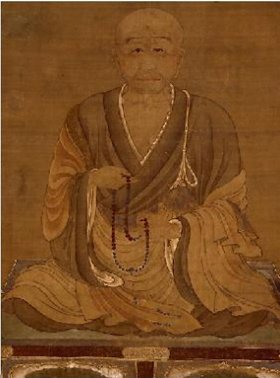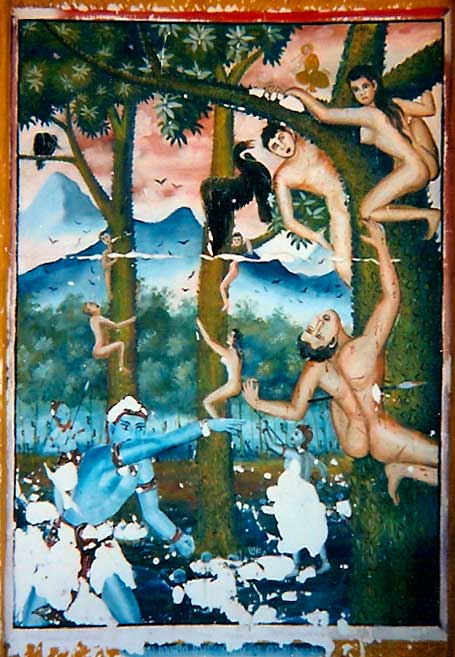|
Ōjōyōshū
The was an influential medieval Buddhist text composed in 985 by the Japanese Buddhist monk Genshin. Three volumes in length and in kanbun prose, the text is a comprehensive analysis of Buddhist practices related to rebirth in the Pure Land of Amida Buddha, drawing upon earlier Buddhist texts from China, and sutras such as the Contemplation Sutra. Genshin advocated a collection of mutually supportive practices, such as sutra recitation, centered around visual meditation of Amitabha Buddha where later Pure Land sects favored an approach that relied on exclusive recitation of the verbal ''nembutsu''. The text is also well known for its graphic descriptions of the Hell realms, and sufferings one might endure for harmful acts committed in this life. Its influence can be seen in Japanese Buddhist paintings and other, later, texts. The founder of Jōdo Shinshū Buddhism, Shinran, wrote an influential commentary on the ''Ōjōyōshū'' titled, "Notes on Essentials of Rebirth", while ... [...More Info...] [...Related Items...] OR: [Wikipedia] [Google] [Baidu] |
Genshin
, also known as , was the most influential of a number of scholar-monks of the Buddhist Tendai sect active during the tenth and eleventh centuries in Japan. Genshin, who was trained in both esoteric and exoteric teachings, wrote a number of treatises pertaining to the increasingly popular Pure Land Buddhism from a Tendai viewpoint, but his magnum opus, the , had considerable influence on later Pure Land teachers such as Honen and Shinran. In spite of growing political tensions within the Tendai religious hierarchy, and despite being one of the two leading disciples of the controversial Ryogen, 18th head of the Enryakuji Temple, Genshin and a small group of fellow monks maintained a secluded community at Yokawa on Mount Hiei solely devoted toward rebirth in the Pure Land, while staying largely neutral in the conflict. He was one of the thinkers who maintained that the nembutsu ritual, which was said to induce a vision of Amida, was an important hermeneutic principle in the Bu ... [...More Info...] [...Related Items...] OR: [Wikipedia] [Google] [Baidu] |
Tendai
, also known as the Tendai Lotus School (天台法華宗 ''Tendai hokke shū,'' sometimes just "''hokke shū''") is a Mahāyāna Buddhist tradition (with significant esoteric elements) officially established in Japan in 806 by the Japanese monk Saichō ( posthumously known as Dengyō Daishi). The Tendai school, which has been based on Mount Hiei since its inception, rose to prominence during the Heian period (794-1185). It gradually eclipsed the powerful ''Hossō'' school and competed with the rival Shingon school to become the most influential sect at the Imperial court. By the Kamakura period (1185-1333), Tendai had become one of the dominant forms of Japanese Buddhism, with numerous temples and vast landholdings. During the Kamakura period, various monks left Tendai (seeing it as corrupt) to establish their own "new" or "Kamakura" Buddhist schools such as Jōdo-shū, Nichiren-shū and Sōtō Zen. The destruction of the head temple of Enryaku-ji by Oda Nobunaga in 1571, ... [...More Info...] [...Related Items...] OR: [Wikipedia] [Google] [Baidu] |
Ōjō
The term Ōjō ( ja, 往生) is a term in Japanese Buddhism for rebirth in the Pure Land of Amitabha Buddha. Sometimes the term is expressed as . The subject of how to obtain birth in the Pure Land remained an important question throughout Japanese Buddhist history even until today. The Nara Schools The early Nara Buddhism schools provided different opinions as to how to obtain rebirth in the Pure Land, though in some cases, such as the Hossō school taught that icchantikas (people who committed the Five Grave Acts) could not obtain rebirth ever. Other schools taught that while accessible to all, the rituals involved were difficult, or that rebirth was not desirable. Tendai and Shingon Early sects, particularly the Tendai and Shingon sects relied on esoteric texts, or interpretations of the Contemplation Sutra to develop rituals and visualizations of rebirth in the Pure Land. Genshin, a Tendai monk, wrote the ''Ōjōyōshū'' in which he described the horrors of Hell i ... [...More Info...] [...Related Items...] OR: [Wikipedia] [Google] [Baidu] |
Naraka (Buddhism)
Naraka ( sa, नरक; pi, 𑀦𑀺𑀭𑀬 Niraya) is a term in Buddhist cosmology usually referred to in English as "hell" (or "hell realm") or "purgatory". The Narakas of Buddhism are closely related to ''Diyu'', the hell in Chinese mythology. A Naraka differs from the hell of Christianity in two respects: firstly, beings are not sent to Naraka as the result of a divine judgment or punishment; and secondly, the length of a being's stay in a Naraka is not eternal, though it is usually incomprehensibly long, from hundreds of millions to sextillions (1021) of years. A being is born into a Naraka as a direct result of its accumulated actions (karma) and resides there for a finite period of time until that karma has achieved its full result. After its karma is used up, it will be reborn in one of the higher worlds as the result of karma that had not yet ripened. In the Devaduta Sutta, the 130th discourse of Majjhima Nikaya, the Buddha teaches about hell in vivid detail. P ... [...More Info...] [...Related Items...] OR: [Wikipedia] [Google] [Baidu] |
Buddhism
Buddhism ( , ), also known as Buddha Dharma and Dharmavinaya (), is an Indian religion or philosophical tradition based on teachings attributed to the Buddha. It originated in northern India as a -movement in the 5th century BCE, and gradually spread throughout much of Asia via the Silk Road. It is the world's fourth-largest religion, with over 520 million followers (Buddhists) who comprise seven percent of the global population. The Buddha taught the Middle Way, a path of spiritual development that avoids both extreme asceticism and hedonism. It aims at liberation from clinging and craving to things which are impermanent (), incapable of satisfying ('), and without a lasting essence (), ending the cycle of death and rebirth (). A summary of this path is expressed in the Noble Eightfold Path, a training of the mind with observance of Buddhist ethics and meditation. Other widely observed practices include: monasticism; " taking refuge" in the Buddha, the , and the ; ... [...More Info...] [...Related Items...] OR: [Wikipedia] [Google] [Baidu] |
Mount Tiantai
Tiantai Mountain (also Tí Taî in the local language) is a mountain in Tiantai County, Taizhou, Zhejiang Province, China. Its highest peak, Huading, reaches a height of . The mountain was made a national park on 1 August 1988. One of nine remaining wild populations of Seven-Son Flower ('' Heptacodium miconioides'') is located on mount Tiantai. Legends In the mythology of Traditional Chinese religion, the creator goddess Nüwa cut the legs off a giant sea turtle () and used them to prop up the sky after Gong Gong damaged Mount Buzhou, which had previously supported the heavens. A local myth holds that Tiantai was on the turtle's back before and Nüwa relocated it to its current position when she had to remove the turtle's legs. Guoqing Temple Guoqing Temple on the mountain is the headquarters of Tiantai Buddhism, and also a tourist destination. Tiantai, named for the mountain, is an East Asian Buddhist school of Mahāyāna Buddhism that developed in 6th-century China and ... [...More Info...] [...Related Items...] OR: [Wikipedia] [Google] [Baidu] |
Iwanami Shoten Publishing
is a Japanese publishing company based in Tokyo.Louis Frédéric, ''Japan Encyclopedia'', Harvard University Press, 2005, p. 409. Iwanami Shoten was founded in 1913 by Iwanami Shigeo. Its first major publication was Natsume Sōseki's novel ''Kokoro'', which appeared as a book in 1914 after being serialized in the ''Asahi Shimbun''. Iwanami has since become known for scholarly publications, editions of classical Japanese literature, dictionaries, and high-quality paperbacks. Since 1955, it has published the ''Kōjien'', a single-volume dictionary of Japanese that is widely considered to be authoritative. Iwanami's head office is at Hitotsubashi 2–5–5, Chiyoda, Tokyo. Company history Iwanami Shigeo founded the publishing firm Iwanami Shoten in the Kanda district of Tokyo in 1913. In its early years, the company published authors such as Natsume Sōseki, Kurata Hyakuzō and Abe Jiro. It also published academic and literary journals in the field of philosophy, includi ... [...More Info...] [...Related Items...] OR: [Wikipedia] [Google] [Baidu] |
Buddhahood
In Buddhism, Buddha (; Pali, Sanskrit: 𑀩𑀼𑀤𑁆𑀥, बुद्ध), "awakened one", is a title for those who are awake, and have attained nirvana and Buddhahood through their own efforts and insight, without a teacher to point out the dharma (Sanskrit 𑀥𑀭𑁆𑀫; Pali ''dhamma''; "right way of living"). The title is most commonly used for Gautama Buddha, the founder of Buddhism, who is often simply known as "the Buddha". Buddhahood ( sa, 𑀩𑀼𑀤𑁆𑀥𑀢𑁆𑀯, buddhatva; pi, buddhatta or ; ) is the condition and rank of a buddha "awakened one". This highest spiritual state of being is also termed ''sammā-sambodhi'' (skt. samyaksaṃbodhi 'full complete awakening'). The title is also used for other beings who have achieved ''bodhi'' (awakening) and ''moksha'' (release from craving), such as the other human Buddhas who achieved enlightenment before Gautama, the five celestial Buddhas worshiped primarily in Mahayana, and the bodhisattva named M ... [...More Info...] [...Related Items...] OR: [Wikipedia] [Google] [Baidu] |
Three Ages Of Buddhism
The Three Ages of Buddhism, also known as the Three Ages of the Dharma (), are three divisions of time following Shakyamuni Buddha's death and passing into Nirvana in East Asian Buddhism. Three Ages The Three Ages of Buddhism are three divisions of time following Buddha's passing: # Former Day of the Dharma — also known as the “Age of the Right Dharma” (; Japanese: shōbō), the first thousand years (or 500 years) during which the Buddha's disciples are able to uphold the Buddha's teachings; # Middle Day of the Dharma — also known as the “Age of Semblance Dharma” (; Japanese: zōhō), the second thousand years (or 500 years), which only resembles the right Dharma; # Latter Day of the Dharma — also known as “the Degenerate Age of Dharma” (; Japanese: mappō), which is to last for 10,000 years during which the Dharma declines. In the Sutra of the Great Assembly (Sanskrit: ''Maha-Samnipata Sutra''; Japanese: ''Daijuku-kyō''), the three periods are further d ... [...More Info...] [...Related Items...] OR: [Wikipedia] [Google] [Baidu] |
Bodhisattvas
In Buddhism, a bodhisattva ( ; sa, 𑀩𑁄𑀥𑀺𑀲𑀢𑁆𑀢𑁆𑀯 (Brahmī), translit=bodhisattva, label=Sanskrit) or bodhisatva is a person who is on the path towards bodhi ('awakening') or Buddhahood. In the Early Buddhist schools as well as modern Theravada Buddhism, a bodhisattva (Pali: ''bodhisatta'') refers to someone who has made a resolution to become a Buddha and has also received a confirmation or prediction from a living Buddha that this will be so. In Mahayana Buddhism, a bodhisattva refers to anyone who has generated ''bodhicitta'', a spontaneous wish and compassionate mind to attain Buddhahood for the benefit of all sentient beings. Mahayana bodhisattvas are spiritually heroic persons that work to attain awakening and are driven by a great compassion (''mahakaruṇā''). These beings are exemplified by important spiritual qualities such as the "four divine abodes" (''brahmaviharas'') of loving-kindness ('' metta''), compassion (''karuṇā''), empatheti ... [...More Info...] [...Related Items...] OR: [Wikipedia] [Google] [Baidu] |




.jpg)
.jpeg/1200px-Gandhara_Buddha_(tnm).jpeg)
